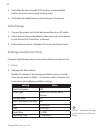
Trilogy200 clinical manual
134
Supplemental Oxygen Warnings
• When administering xed-ow supplemental oxygen,
the oxygen concentration may not be constant. The
inspired oxygen concentration will vary, depending on
the pressures, patient ows and circuit leak. Substantial
leaks may reduce the inspired oxygen concentration
to less than the expected value. Appropriate patient
monitoring should be used, as medically indicated, such
as an alarming pulse oximeter.
• This device DOES NOT alarm for loss of the low ow
oxygen supply.
• Oxygen supports combustion. Oxygen should not be
used while smoking or in the presence of an open ame.
• Do not connect the device to an unregulated or high
pressure oxygen source.
• The device may result in incorrect ow and tidal volume
measurements and improper operation of related alarms
if you add low ow oxygen directly into the patient
circuit or mask instead of directly adding it into the
oxygen inlet on the back of the ventilator.
• If oxygen is used with the device, the oxygen ow must
be turned o when the device is not in use. Explanation
of the Warning: When the device is not in operation
and the oxygen ow is left on, oxygen delivered into the
tubing may accumulate within the device’s enclosure.
• The ventilator should not be operated in the presence of
ammable gasses. This could cause a re or explosion.
Using a Remote Alarm Unit
You can use a Philips Respironics Remote Alarm unit with your
device. There is a dedicated adapter cable assembly for connecting
the device to the Remote Alarm unit (REF 1045291). Refer to the
instructions included with your Remote Alarm unit and adapter cable
assembly if you have questions on how to use it with device.
WARNING
The remote alarm should be
tested daily. When using a
remote alarm, make sure you
fully test the remote alarm
connector and cable by verifying
that:
- Annunciated alarms on
the ventilator are also
annunciated on the remote
alarm.
- Disconnecting the remote
alarm cable from the
ventilator or from the remote
alarm results in an alarm
notication at the remote
alarm.


















